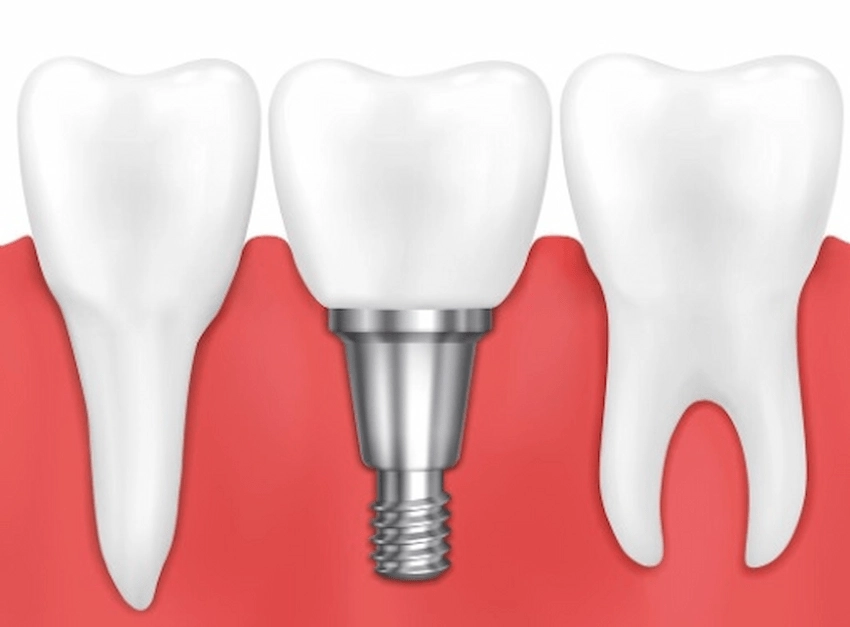🦷How Long Do Dental Implants Take?

The period for tooth implants basically differs greatly amongst individuals and their situations too. On average and depending on a number of factors, patients generally undergo tooth implant procedures that take so much time that can be measured in terms of months. Procedures related to dental implants are long and consist of a number of stages which include surgical and rehabilitation processes.
While there are some people who are able to complete the procedure after a relatively short period of time, there are some who cannot do it because of their special needs in terms of their dental state. Various factors such as patients’ oral health and other medical conditions affecting the case or the number of dental implants that have been placed in the jaw bone affects the whole process length. Therefore, it is always advisable to consult a dentist who does or works in the implant field so that he or she can assess your case and break down your specific needs based on the outlined factors.
Factors Influencing the Duration of the Dental Implant Process
The length of time taken to complete the dental implant process is made long by the numerous factors that are applicable to the individual cases. Basically, the general condition of the patients’ oral cavity is of the utmost importance, as if there are any existing dental conditions within the mouth since, they will necessitate the administration of other procedures before implants can be placed and this can extend the period of time that is taken.
Secondly, the length of time for installation of the implants is determined by the type of installation that is being done, which includes the number of implants to be inserted and the areas where these implants will be positioned in the mouth. Similarly, other aspects like, the assessment of the bone mass present as well as the health of the gums before placing implants could take some time too, as these have great effects on the time that is needed for the process of osseointegration and full attachment of the dental implant to the bone. Lastly, the degree to which the patients adhere with the instructions given to them after surgery also has a great role in the entire length of time of the process.
Step-by-Step Timeline of the Dental Implant Procedure

Knowing the entire detail of the whole process of dental implant procedure helps to simplify the process. The very first step of the procedure starts off with the first visit to a dentist who is a specialist in dental implants who is going to evaluate the condition of the patient’s dental and set out the details of the method for that specific patient. When all things are set and done any procedure that was supposed to be done before the actual operation can now be carried out.
The surgery itself consists of the placement of the dental implant into the jawbone, after that comes the process of healing known as osseointegration whereby the implant fuses itself with the bone. After a period of fade away, a few months to a few years, when the bony union was clear and progressed, it was appropriate to place the abutment, an element most important for its last development after which the prosthetic restoration should be attached to it.
Despite the fact that the process of dental implants seems to be long and demanding, every open heart will be changed drastically as this method is the best way of restoring the coveted harmony of a smile and of discovering a life without the hectic tension of missing teeth.
1. Initial Consultation
The preliminary visit is undoubtedly the most vital aspect of getting dental implants from a dentist and also an educational experience for the patient. The doctor thus evaluates the patient’s oral conditions first by using various proper diagnostic means such as clinical examinations and CT scans. The step-by-step check-up eventually leads to the conclusion of whether the patient is a good candidate for implants or other existing oral conditions that might hinder the procedure.
In the initial phase, the surgeon outlines the basic information about the dental implant surgery, its stages, duration, risks, and potential results of the treatment, and also a fully-fledged guide and explanation regarding any questions the patient may have. Additionally, a thorough examination of the patient’s medical record is carried out by the dentist in order to ensure the patient’s safety in following the treatment procedure. The consultation becomes the foundation of the entire treatment procedure, in which a personalized plan is prepared with the patient’s own needs and requirements.
2. Preliminary Procedures
- In very few cases, the dentist may need to undertake some preliminary procedures before the actual placement of the dental implants into the patient’s mouth. The goal of these preparations is to ensure that the conditions of the jaws are the best ones for placement of the implants. Such measures may involve a number of the following procedures:
- Extraction of Teeth: If there are some severely compromised teeth in the patient’s mouth, the dentist may recommend their prompt removal to enable proper placement of the implants in the future.
- Bone Grafting Procedure: If a patient’s jaw lacks sufficient bone mass to support an implant installed, a procedure known as bone grafting can be performed to enhance the bone structure so that it becomes strong enough to anchor the implant. Bone grafting will create a new bone using the patient’s own, or another compatible bone material. This is done after assessing the condition of the jaw using X-rays.
- Sinus Lift: If the patient is to get an implant in the upper jaw then the dentist may recommend a sinus lift, a special process that raises the floor of the sinuses and hence creates extra space in which a dental implant can be placed. The sinus lift gets the right volume of bone at the right location that provides the required support for the implant. All these steps aim to create the best possible conditions for successful placement of the implants.
3. Implant Placement Surgery
The surgery of this phase is a procedure where the actual titanium implant is placed in the patient’s jaw and it should be regarded as a key element in the process of getting dental implants. Under local anesthesia or sedation, the surgeon performs a careful procedure during which a small incision is made in the gum tissue and the bone of the jaw is exposed. The surgeon will prepare the bone bed for the titanium implant to be properly anchored into the jaw.
Placement of each implant may take from one to two hours, depending on how complex it is. Once the implant is securely in place, the gum is closed with stitches with care considering the need for healing around the implant. This implant will act as the root for the future prosthesis and may require some time to integrate into the surrounding bone. The method is referred to as osseointegration, during which the bone grows around the dental implant and joins it. Osseointegration may take several months (in most cases from three to six), but in the end, it ensures that prosthodontics will function and last for as long as possible, just like natural teeth would.
4. Osseointegration Phase
The osseointegration phase refers to the time during which the titanium dental implant has to fuse with the jawbone. The osseointegration phase takes up to six months over a period of three months on average. The process then applies igging bimetallic Lahti Mors algorithms to obtain solid support for the tooth orthodontic structure. It is an uncontrollable write bitive process that is essential for the future success of dental implants.
The length of the osseointegration process is mainly determined by the density and quality of the bone as well as the capacity of the individual body to heal itself. It is very important that during this period, the patients follow all the after-care instructions carefully and sensibly to aid in the healing process and early integration of the implant.
5. Abutment Placement
Abutment placement comes next after the osseointegration realizations of the implant carry the fabrication process post-healing. When the dental implant achieves maximum fusion with the jawbone, the dentist makes a small incision in the gum to uncover the implant. The abutment, made of metal as they get connected to the implant using screws or cement, is a small piece that connects an implant to a crown, bridge, or denture. This requires a minor surgical procedure with some anesthesia, and it is through the abutment that the final restoration gets anchored. After the abutment placement, it is essential to allow the gums enough time to heal, usually around two weeks, to ensure that the abutment is fully integrated into the gum tissue.
6. Placement of the Permanent Restoration
The final stage of the dental implant procedure is the placement of the permanent restoration. After sufficient healing of the abutment and confirmation of the healthiness of the gum tissues surrounding the implant, the dentist takes a set of accurate impressions of the patient’s mouth to create a crown that matches the natural teeth of the patient with the same shade and shape. The dentist has then t]he construction of a permanent crown for a suitable abutment.
The crown not only restores the function of the teeth but also improves the appearance of the smile, making them look and behave like natural teeth. They will let the patients chew, smile, and speak without having to worry about the performance of the dental implants. If the patient adheres to the necessary care and checks for the periodical maintenance programs, the dental implant and the restoration can last a lifetime.
Total Estimated Time for the Entire Process

The total amount of time that it would take to have your dental implants would usually last for five to eight months, depending on the patient’s unique circumstances and needs. If you are also facing some preparatory treatments like tooth extractions or bone grafting, these times may vary and hence the general period may increase.
Though, the implant placement and the osseointegration phase are known to last about three to six months. After the integration is done, abutments and the final restoration of the dental implants can be done within a period of a few weeks. Although this process is very effective and one worth trying, it is essential to note that every patient is unique and therefore if you want a more personal timeline based on your individual need, consulting with a dental professional is key.
Factors That May Prolong the Implant Process
Even though the recommendation would be to have dental implants, it is also essential to note that there are some factors that might cause delays and prolong the entire process. The first argument is that being susceptible to poor oral health or having other existing dental conditions might require other likely treatments alongside the primary treatment that is dental implants and thus delay the process of getting dental implants.
Secondly, the necessity for preliminary procedures like bone grafting can cause the entire dental implant process to extend for long periods of time as the healing would take more time and would generally require a second set of surgery. Furthermore, factors such as smoking, inadequate intake of proper nutrition and lack of proper post-operative care could have a negative effect on healing after the dental implant process and even the final result.
Finally, it is indeed a well-known aspect that some patients might face complications during the whole procedure which would cause an extended time due to the need for extra efforts to deal with such situations and again a possible increased period of recovery after the procedure is finished to its end.
Tips to Ensure a Smooth and Timely Implant Process
Dental implant surgery is not always a common procedure but when patients have some advanced knowledge it can make all the difference in influencing their success. This article will help you learn techniques on preventing infections and complications ensuring good oral hygiene before and post-surgery. To begin with, it is important for individuals to follow their dentists’ advice, pay attention, and ask questions.
Adherence to pre-op and post-op guidelines is definitely the way to go for swift healing to occur. Having oral health is an integral part of the entire process as bad habits that can lead to complications or prolong the recovery duration should be avoided. Smoking may slow down the healing process so it should be avoided completely as the presence of cigarette smoke can negatively affect the body’s healing processes in the immediate tooth transplant site and other body parts thus making anything difficult.
During this period after surgery, it is of paramount significance to reduce alcohol consumption as researchers show that alcohol hinders the operation of the immune system. A strong immune system is very useful when shouldering its task of repairing the body parts. A balanced diet constituted of vitamins and minerals that enhance healing should be opted for by the patients.
How Long Do Dental Implants Take? FAQs
The process of getting a dental implant is rather involved and the duration can be of utmost importance when it comes to managing clients’ expectations as well as recovery planning. Hence, as you read further, you will find an answer to some common queries that people tend to ask regarding the timeline from the initial consultation to the completion of the final restoration as regards the process of dental implants.
The entire dental implant process typically takes several months. On average, it can take anywhere from 3 to 9 months, depending on factors such as the need for bone grafting and healing time after the initial surgery.
The surgical part of the dental implant process usually takes about 1 to 2 hours per implant. However, this may vary based on the complexity of the case, such as the need for additional procedures like bone grafting.
The process of osseointegration, where the implant fuses with the jawbone, typically takes 3 to 6 months. During this period, it is crucial to avoid putting stress on the implant to ensure proper integration.
Once the implant has successfully fused with the bone, it generally takes another 2 to 4 weeks to place the permanent crown or restoration. This time allows for fitting and customization to ensure a perfect match with your natural teeth.
You can generally resume light activities, such as walking, the day after surgery. However, strenuous activities should be avoided for about 1 to 2 weeks to allow the implant site to heal properly.
Most swelling and discomfort from dental implant surgery should subside within 2 to 3 days. Pain is usually mild and can be managed with over-the-counter pain relievers as advised by your dentist.
If bone grafting is required, the healing time is extended. It can take 4 to 6 months for the bone graft to fully heal before the implant can be placed.
Implants in the lower jaw may heal faster than those in the upper jaw, often requiring around 3 to 5 months for osseointegration before a permanent restoration is placed.
While initial healing usually takes about 2 to 3 months, complete recovery may take up to 6 months, depending on the individual and the complexity of the implant case.
You will have follow-up appointments with your dentist at regular intervals throughout the healing process. Initial check-ups will be scheduled within the first week of surgery, with additional visits during the healing phases to ensure proper recovery.




